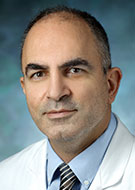The Effects of Moral Injury in Radiology
Misalignment between moral or ethical values and everyday actions can take its toll



This story is part of an RSNA News special focus on moral injury among radiologists.
The misalignment between the increasing volume and complexity of imaging studies and the ability of the shrinking pool of radiologists to keep up with the demand—without compromising patient care—has added new dimensions to burnout and moral distress in the specialty.
The term moral distress was coined in 1984 to describe the suffering nurses experience when institutional or systemic barriers prevent them from acting in accordance with their moral principles and ethical responsibilities. Over time, the concept has broadened to include other medical professions.
“Moral distress is essentially the feeling that you are uneasy with or unable to perform your job because you don’t have the resources or because it’s not aligned with what you want to do,” said Rama Ayyala, MD, associate professor of radiology and associate chief of culture, quality and safety at Cincinnati Children’s Hospital Medical Center.
This unease extends beyond what some may consider professional dissatisfaction when the malalignment creates barriers to proceeding according to what one perceives as ethically most appropriate.
“Some causes can include insufficient staffing, insufficient time and feeling like you’re not trained appropriately for the things you’re doing,” Dr. Ayyala said.
Moral injury results from repeated instances of moral distress, which may occur from witnessing patient suffering, enduring staffing shortages and health insurance barriers that lead to a poor quality of care or being subject to rationed care and personal protective equipment during crises.

The Relationship Between Burnout and Moral Injury
Burnout refers to a state of emotional exhaustion from chronic work stress, while moral distress is the feeling of knowing the right action to take but being unable to due to systemic constraints. Moral injury is a deeper psychological wound caused by witnessing or performing actions that violate one’s deeply held moral beliefs, often leading to feelings of guilt and shame.
The relationship between burnout and moral distress is not uniformly agreed upon. Some experts understand moral injury as one distinct root cause of burnout, and they see institutional avenues that are possible for mitigating both. Others see moral injury as distinctly separate and intractable once it has taken hold.
“Every physician during their professional career will likely experience some kind of burnout, but we take corrective measures and move forward,” said Christos S. Georgiades, MD, PhD, professor of radiology and radiological science at Johns Hopkins Medicine, Baltimore. “Moral injury is an entirely different beast—it’s very serious and generally irreversible.”
Both burnout and moral injury may stem from the divergence of purpose between institutions and physicians. Both may extend from physicians’ experiences of increasing lack of control about the priorities for the profession, compounded by excessive administrative burdens and an opaque layer of bureaucratic hurdles. Moral distress, as distinct from deep professional disaffection, may take hold as physicians perceive a forced compromise in their ability to take care of patients.
“We entered medicine fighting on behalf of patients,” Dr. Georgiades said. “But a couple of decades later, the goalposts have shifted. Our ‘enforced’ objectives are often irrelevant to the delivery of health care and more aligned to financial and sociopolitical metrics. So that’s a divergence of purpose.”
“People want to feel like they have meaning and purpose in their job and that they’re making a difference, whether through patient care, research or education. That purpose can be completely lost in the rigor of just trying to get things done.”
– BETTINA SIEWERT, MD
Prevalence Among Radiologists
According to a study co-authored by Bettina Siewert, MD, executive vice chair of radiology at Beth Israel Deaconess Medical Center, Boston, moral distress is highly prevalent among radiologists. In the American Journal of Roentgenology study, a national survey of radiologists found that 98% of respondents reported experiencing some degree of moral distress and 18% had left a position because of it.
The research team also reported that 13.9% of radiologists left their practices between 2017 and 2018, compared to 8.7% from 2014 to 2015.
“People are leaving medicine and radiology because of moral distress,” Dr. Siewert said. “People want to feel like they have meaning and purpose in their job and that they’re making a difference, whether through patient care, research or education. That purpose can be completely lost in the rigor of just trying to get things done.”
Patients can also suffer the consequences of their providers’ moral distress and burnout.
“Patients only see their providers for a few minutes, and more and more of their interaction is via emails or messages,” Dr. Ayyala added. “If, as a physician, you are busy and being pulled in multiple directions, it’s very obvious to patients that you’re distracted and not completely present.”
Countering the Effects
Dr. Siewert said the top countermeasures for moral injury mentioned by survey respondents were educating leadership on sources of moral distress, the ability to engage in inter-specialty dialogue and utilizing more ethics consultations.
“While working under distressing conditions, we are having conversations and thinking about longitudinal plans,” Dr. Siewert said. “But I think there is room for institutional leaders to really understand the gravity of the situation.”
To truly eradicate both moral distress and burnout, health care leaders will need to restructure systems and address the stressors beyond the control of physicians, including revenue generation, administrative issues, competing incentives and health insurance barriers.
In the meantime, radiology leaders can explore ways to create small shifts, such as giving people more respite between reading studies, offering more flexibility in work hours and working to reduce unnecessary imaging.
Other steps radiology departments can take include establishing inter-specialty work groups to agree on imaging protocols and educating providers on imaging appropriateness criteria.
Experts say meditation, mindfulness, and resilience skills are helpful practices—but they won’t address the root cause of moral injury. However, practicing self-empathy and acceptance may help in the healing process.
Radiology groups should strive to foster a culture of openness and social cohesion, which can go a long way toward supporting staff members. Individuals experiencing moral distress may find relief by sharing with a trustworthy listener. Being part of the solution by participating in conversations with leadership or work groups addressing appropriate ordering or streamlined workflows can also instill a greater sense of control.
Dr. Ayyala said having recognition through national organizations, such as RSNA, is a great way to spread awareness of this critical issue. “That’s how we started discussing burnout,” she said. “And that’s where we are now with moral injury and distress.”
For More Information
Access the American Journal of Roentgenology study online at AJROnline.org.
Read previous RSNA News stories on radiologist health and well-being: